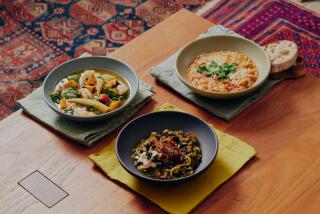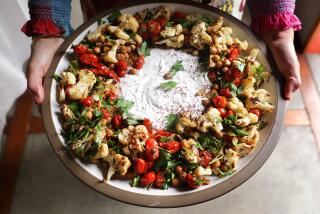Five or fewer: Throw together a quick meal from a well-stocked pantry
I have always admired people who can cook a delicious meal when there’s nothing in the fridge. My mother-in-law is one such wizard in the kitchen. I have lost count of the times that she has, without any advance planning, transformed what seemed like nothing into breakfast for six. Over the years, I’ve learned that while this stone-soup cooking may seem magical, it is just a combination of creativity, cleverness and a wellstocked pantry.
You’ll want to set yourself up for success by keeping some essentials in your kitchen. That way, even when you haven’t had a chance to go grocery shopping in the middle of a busy week, you will still have things to work with. My pantry leans Mediterranean: I always stock a package or two of dried pasta, plus rice, farro or some other whole grains. Beans are key; dried beans take about an hour to cook, whereas canned ones can be used right away. Tartness is important for balancing a dish, so you’ll need acidic ingredients such as vinegar for those days when you’re out of fresh lemons and limes. You’ll also want some salty-umami ingredients like olives, soy sauce or anchovies. They add a wallop of flavor.
You can store staples in the freezer too. Slice a loaf of good country-style bread and freeze it in a zip-top plastic bag alongside bags of nuts. To instantly revive both bread and nuts, toast them on a baking sheet in the toaster oven or in a skillet on the stovetop.
The following recipes have five or fewer ingredients (not including salt, pepper and olive oil) and don’t rely on anything perishable. (Garlic is shelf-stable; you can store eggs in the fridge for weeks!) You can cook any of these dishes when the refrigerator is nearly empty. Try them and suddenly, miraculously, your pantry won’t just be the place you store ingredients; it will become a source of inspiration.
Midnight pasta
One of my favorite Italian traditions is spaghettata, a feast of piping hot pasta cooked at home late at night, often after you’ve come home from the bar, when you are hungry and not quite ready for bed. Substitutions abound in this recipe. Instead of capers, try using another small, salty ingredient like olives or anchovies. Swap out the pine nuts for another rich, buttery ingredient like chopped walnuts or grated hard cheese.
20 minutes. Serves 4
Kosher salt
5 tablespoons extra-virgin olive oil, divided
5 garlic cloves, thinly sliced
1/3 cup pine nuts
3 tablespoons capers, rinsed
Red chile flakes (optional)
1 pound dried pasta of any shape
Freshly ground black pepper
1. Bring a large pot of generously salted water to a boil.
2. Meanwhile, heat 2 tablespoons oil in a large skillet over medium heat. Add the garlic and cook, stirring often, until light golden, about 1 minute. Add the pine nuts, capers and a pinch or two of chile flakes, if using, and season with 1/4 teaspoon salt. Cook, stirring, until the nuts are toasted, about 3 minutes. Remove the pan from the heat.
3. Once the water is boiling, add the pasta and cook until al dente. (Taste a noodle after 5 minutes and again every minute thereafter. The pasta is done when it tastes soft but still has a pleasantly chewy resistance when you bite down.)
4. Reserve about 1 cup of the pasta cooking water, then drain the pasta. Transfer the noodles directly to the skillet, set it over medium-high heat, and add about three-quarters of the reserved water and the remaining 3 tablespoons oil. Cook, stirring often, until the sauce coats the noodles, 1 to 2 minutes. There should be a little sauce pooling at the bottom of the skillet; if there is not, add more cooking water and stir well. Season with more salt and pepper, if you like, and serve hot.
Za’atar farro with fried eggs
Za’atar farro with fried eggs »
This dish is a variation on fried rice. Toasting the dry farro grains before boiling gives them an even bolder roasted nut flavor than usual. I like to stir in a dried herb mix such as za’atar, but you can use another spice blend or chopped fresh herbs if you have some. Few dishes are as satisfying for breakfast, lunch or dinner.
50 minutes. Serves 4
Kosher salt
2 cups farro
5 tablespoons extra-virgin olive oil, divided
1 small yellow onion, finely chopped
1/4 cup dried herb mix, such as za’atar
4 garlic cloves, thinly sliced
Freshly ground black pepper
4 large eggs
1. Bring a large pot of generously salted water to a boil.
2. Heat a large skillet over high heat. Add the farro and cook, stirring often, until it turns a shade darker and smells nutty, about 6 minutes. Transfer the toasted farro to a bowl and wipe out the skillet and reserve.
3. Once the water is boiling, add the toasted farro and cook until tender, 20 to 30 minutes. Drain.
4. Heat 3 tablespoons oil in the reserved skillet over medium-high heat. Add the onion and cook, stirring occasionally, until softened and just starting to brown, 3 to 4 minutes. Add the farro and dried herb mix, and cook, stirring every minute or so, until the farro is well-coated, about 5 minutes. Use a spoon to move the farro to the sides of the skillet, creating a little empty space in the middle. Lower the heat to medium-low and add the garlic to the empty space along with 1 tablespoon oil and 1/2 teaspoon salt. Cook for 30 seconds, then mix the garlic into the crispy farro. Season with more salt and pepper and transfer the farro to a serving plate.
5. Return the skillet to medium-high heat. Swirl in the remaining 1 tablespoon oil, crack in the eggs, and season them with salt and pepper. Cook until the whites are set but the yolks are still runny, about 4 minutes. Serve the eggs on top of the za’atar farro.
Smashed white beans and frizzled sage toast
View recipe in our California Cookbook: Smashed white beans and frizzled sage toast »
When you drop a sage leaf into hot oil, it sputters, frizzles and becomes as crisp as a potato chip in a matter of seconds. As a bonus, the oil takes on the woodsy scent of sage and is brushed on the bread and mixed into the white beans for extra flavor.
15 minutes. Serves 4 to 6
1/4 cup vegetable oil
1 bunch fresh sage, stems trimmed
Kosher salt and freshly ground black pepper
6 thick slices country-style bread
2 garlic cloves, smashed to a paste (see Tip)
1 (15-ounce) can cannellini beans, drained and rinsed
2 teaspoons red wine vinegar or 1 tablespoon freshly squeezed lemon juice
1. Heat the oil in a small skillet over medium heat. Fry 3 sage leaves at a time until crisp, 2 to 4 seconds. Use a fork or slotted spoon to transfer the sage to a paper-towel-lined plate. Sprinkle with salt and pepper and let cool. Reserve the sage oil in the pan. (If the sage browns, the oil is too hot; remove it from the heat and let cool for a moment before continuing to fry the sage.)
2. Heat a large skillet over medium heat. Use about 1 tablespoon of the sage oil to brush the bread slices on one side. Place as many slices as will fit in a single layer in the skillet and toast until dark golden brown on the oiled side. Repeat to toast all the bread. Transfer the toast to a serving platter.
3. Add the remaining sage oil to the large skillet, followed by the garlic, beans and vinegar or lemon juice. Cook for 1 minute, stirring often and using the back of the spoon to smash some of the beans, creating a pleasing mix of whole, smashed and partially smashed beans. Season with salt and pepper.
4. Spread each toast with some smashed white beans. Sprinkle with the frizzled sage and serve.
Tip: How to Smash Garlic
To turn fresh garlic cloves into a paste, mince the garlic on a cutting board, then sprinkle with a pinch of salt. Use the flat side of your knife to smash and scrape the garlic and salt together, cleaning the mash off the side of your knife by smearing it against the board. Repeat until it becomes a smooth paste. The salt breaks down the garlic so it incorporates more evenly into whatever you’re cooking and helps tame some of its bite in raw preparations like salad dressings or dips.
— Ben Mims
Chai-fogato
You may have had affogato — hot espresso poured over cold gelato — but have you ever tried chai-fogato? I love to make a dairy-free version using almond milk ice cream, which complements the spices in masala chai even better than regular ice cream does. This is a dessert (or an afternoon treat) you can serve at a moment’s notice.
15 minutes. Serves 4
1/4 cup packed light brown sugar
2 masala chai tea bags
1 pint vanilla ice cream (dairy-free or regular)
1. Combine the sugar and 1 1/3 cups water in a small saucepan and bring to a simmer over medium-high heat, stirring until the sugar dissolves. Once the syrup comes to a simmer, cook until reduced in volume to 1 cup, about 8 minutes. Remove from heat, add the tea bags and let steep for a few minutes. Discard the bags and transfer the chai syrup to a small pitcher.
2. Scoop the ice cream into four coffee cups. For ideal melting speed, tightly pack the scoop. Pour about 1/4 cup hot chai syrup over each mound of ice cream. Serve right away.
More to Read
Eat your way across L.A.
Get our weekly Tasting Notes newsletter for reviews, news and more.
You may occasionally receive promotional content from the Los Angeles Times.









